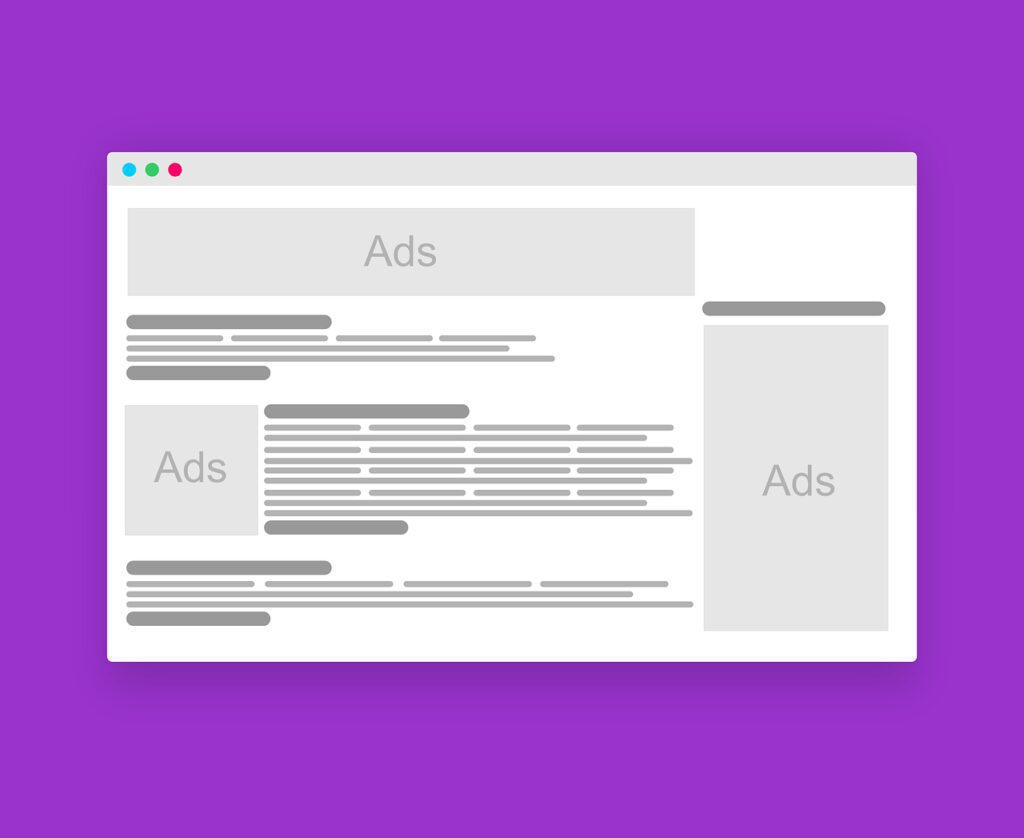Online advertising, also known as digital advertising, refers to any form of marketing that uses the Internet to deliver promotional messages to consumers. This type of advertising encompasses a variety of formats, including but not limited to display ads, banners, search engine advertising (SEM), e-mail advertising, social media marketing, and more. These ads can be personalized to reach specific segments of users based on their browsing behavior, interests or geographic location.
This article aims to explore the most effective methods and innovations in online advertising to enable businesses of all sizes to maximize the ROI of their digital advertising campaigns. We'll discuss advanced targeting and segmentation strategies, the judicious use of data and emerging technologies such as AI for ad optimization, and best practices for designing engaging and memorable campaigns. Through detailed case studies and practical advice, this article will provide readers with the skills they need to innovate and excel in their digital marketing efforts.
Understanding the fundamentals of online advertising
The different types of online advertising
Online advertising comes in a variety of formats, each meeting specific objectives and using different strategies to reach and engage consumers. Here are the main types:
- Display advertisingThese visual ads are placed on partner websites (via networks like Google Display Network) and can take the form of banners, interstitials or videos. Their aim is often to generate brand awareness through wide distribution.
- SEM (Search Engine Marketing)SEM involves buying keywords to appear in paid search results. Google AdWords is one of the most popular platforms for this, using a pay-per-click (PPC) system where advertisers pay for each click on their ads.
- Social advertising: Used on platforms such as Facebook, Instagram and Twitter, this method involves creating ads that blend into users' news feeds, allowing them to interact (for example, through likes, shares and comments).
- RetargetingThis technique aims to target users who have already visited a website without making a purchase. Cookies are used to follow these users around the web and present them with the ad again, increasing the likelihood of conversion.
- Native advertisingUnlike traditional display ads, native advertising blends into the content of the site where it is published, making it less intrusive and often more effective. It can take the form of sponsored articles or integrated promotional videos.
How does online advertising work?
The implementation of online advertising relies on complex technologies and strategies designed to maximize the impact of campaigns.
- The role of cookies and behavioral targeting:
- CookiesCookies: Small files stored on the user's browser, cookies collect data on online behavior, such as sites visited, purchases made, and interactions with ads. This data enables advertisers to offer hyper-targeted ads tailored to the user's interests.
- Behavioral targetingAdvertiser: Uses cookie data to display personalized ads to specific users. For example, if a user is looking for flights to New York, they might see ads for hotels in New York on other sites.
- The importance of SEO and SEA in online advertising:
- SEO (Search Engine Optimization)SEO: Optimizing the on-page and off-page elements of a website to improve its ranking in organic search results. Although not directly paid advertising, SEO is crucial to increasing online visibility.
- SEA (Search Engine Advertising)Includes techniques such as PPC, which are used to obtain prime positions in search results through keyword auctions, guaranteeing maximum visibility.
Advantages of online advertising over traditional media
Online advertising offers several decisive advantages over traditional methods:
- Precise targetingThanks to the richness of digital data, advertisers can reach specific groups of users based on demographics, interests and behaviors much more precisely than in traditional media.
- Measurability and adjustabilityThe results of digital campaigns can be measured in real time, with indicators such as click-through rate (CTR), impressions and cost-per-acquisition (CPA). This makes it possible to quickly adjust strategies to optimize performance.
- Cost-effectivenessWith models like PPC, advertisers only pay when their ads reach their goal (e.g., a click), which can lead to a higher return on investment (ROI).
- Interactivity and commitmentDigital formats enable direct interaction with consumers, fostering deeper engagement that can be transformed into concrete actions (purchases, subscriptions).
In short, understanding these fundamentals enables companies to effectively navigate the complex landscape of online advertising and use these tools to propel growth and achieve their marketing objectives with precision.
Advanced strategies for online advertising
Campaign personalization
Personalization is at the heart of effective online advertising. It enables brands not only to reach their audience, but to resonate with them on a personal level, increasing the chances of conversion.
- Using user data for precise targeting:
- Collecting dataThrough user interactions with the website and ads, collect demographic data, preferences and browsing behavior.
- Data analysis and useUse analytical tools to decipher this data and identify patterns that will help target users with ads specifically tailored to their interests and needs.
- Advanced segmentation techniques:
- Demographic segmentationTarget audiences based on age, gender, geographic location and other demographic variables.
- Behavioral segmentationGroups of users formed according to their browsing and transaction history - for example, users who have abandoned their shopping cart are targeted with reminder ads.
- Psychographic segmentationTargeting based on users' attitudes, interests and values. This method is particularly powerful for connecting on an emotional level.
Optimizing your advertising budget
Effective management of the online advertising budget is crucial to maximizing ROI while minimizing unnecessary expenditure.
- Cost models: CPC, CPM, CPA:
- CPC (Cost per Click)You only pay when your ad is clicked. Ideal for campaigns aimed at increasing site traffic.
- CPM (Cost per thousand impressions)Payment based on the number of times the ad is shown, regardless of interactions. Preferable for brand awareness objectives.
- CPA (Cost per Acquisition)You pay when a specific action (purchase, registration) is completed. Perfect for conversion-oriented campaigns.
- Real-time adjustment and redistribution of budgets:
- Real-time tracking: Use software that tracks live campaign performance to react quickly to any changes.
- Adjusting budgetsReallocate budgets from under-performing segments to those with higher returns to optimize overall efficiency.
- A/B testing: Continuously test different versions of ads to determine which perform best in terms of conversion and engagement.
Creating engaging advertising content
Ad content can captivate interest and persuade consumers to act, making content quality and relevance two pillars of advertising success.
- The importance of design and visual quality:
- Visual appealUse eye-catching colors, layouts and visuals that capture attention and are in keeping with the brand.
- Image and video qualityInvest in high-quality graphics and professional videos that reflect the brand's professionalism and message.
- Persuasive writing and an effective call to action:
- Tone and styleAdapt the tone and style of the content to the target audience and the platform on which the ad will appear.
- Calls to action (CTAs)CTAs should be clear, convincing and call for immediate action, such as "Buy now", "Sign up for free", or "Discover more".
- Message personalizationCustomize the ad's message according to audience segment to increase content resonance and relevance.
By integrating these advanced strategies into your online advertising campaigns, you can not only significantly improve the performance of your ads, but also ensure optimal use of every euro invested. These approaches will help you create advertising campaigns that not only reach their target audience accurately, but also engage and convert effectively.
Technological innovations in online advertising
Artificial Intelligence (AI) and Machine Learning (ML)
AI and ML are revolutionizing the way advertising campaigns are designed, executed, and optimized, enabling unprecedented levels of personalization and effectiveness.
- Automated auctions:
- Real-time optimizationAI systems can automatically adjust bids for keywords and ad placements according to conversion probability, maximizing results while minimizing costs.
- Predicting resultsML analyzes historical data to predict the performance of different bidding strategies, helping to make informed decisions about budget allocation.
- Large-scale content personalization:
- Dynamic contentUsing AI to generate personalized ads in real time, based on users' behavioral and demographic data. This includes modifying visuals, titles, and messages according to the user viewing the ad.
- Product recommendationsML algorithms can suggest specific products or services to individuals by analyzing their past behavior, similar to the way recommendations are made on sites like Amazon.
Using augmented and virtual reality
Augmented reality (AR) and virtual reality (VR) offer immersive experiences that can transform online advertising into palpable, memorable interactions.
- Virtual tests: AR allows consumers to virtually try on products, such as glasses, watches, or clothing, from their phone or computer, which can increase conversion rates and reduce product returns.
- Immersive toursUse VR to create virtual tours of locations or immersive product experiences, ideal for real estate, tourism or major events.
- Increased interactivity: Ads using AR/VR engage users through their interactive aspect, increasing time spent with the brand and improving perceptions of value and quality.
Impact of new regulations on advertising technologies (e.g. RGPD).
Regulations such as the General Data Protection Regulation (GDPR) in Europe are having a profound impact on online advertising practices, particularly with the use of advanced technologies such as AI.
- Consent and transparency: The GDPR requires users to be fully informed and give their explicit consent before their data is collected and used for advertising. This requires changes in advertising technologies to ensure they are compliant.
- Limitations on targeting and profilingRestrictions on the use of personal data for behavioral targeting are forcing advertisers to find new segmentation methods that respect users' privacy while remaining effective.
- Data security and anonymizationStrengthen security measures to protect user data against breaches, and use anonymization techniques to minimize risks in the event of data leakage.
These technological innovations aren't just gadgets; they represent the future of online advertising. By embracing AI, AR/RV, and complying with new regulations, brands can create campaigns that are more relevant, engaging and respectful of user privacy. These technologies offer extraordinary opportunities to connect with consumers in a deeply personalized and immersive way, while navigating the complex regulatory framework that continues to evolve.
Common mistakes in online advertising and how to avoid them
Online advertising, while powerful, is also prone to common mistakes that can compromise campaign effectiveness and ROI. Identifying these pitfalls and understanding how to avoid them can greatly improve the performance of your marketing initiatives.
Ignoring the importance of mobile
Error Failure to optimize campaigns for mobile devices, despite the fact that the majority of users access the Internet via their smartphones.
Consequences :
- Poor user experienceNon-mobile-optimized sites and ads can be difficult to navigate, increasing bounce rates and reducing conversions.
- Reduced visibilityGoogle and other search engines penalize sites that aren't mobile-friendly, negatively affecting search rankings.
Solutions :
- Responsive designMake sure your website and ads adapt and function perfectly on all types of devices and screen sizes.
- Loading speedOptimize page loading speed for mobile connections, which are often slower, by compressing images and using modern caching.
- Testing on different devices: Regularly test your ads and landing pages on a variety of mobile devices to ensure a consistent user experience.
Neglecting A/B testing
Error Don't carry out A/B tests to evaluate the effectiveness of different elements of an advertising campaign.
Consequences:
- Decision-making based on assumptionsWithout A/B testing, campaign modifications are based on intuition rather than hard data.
- Missed opportunitiesFailure to identify which ad variations generate the most engagement and conversions can lead to sub-optimal campaigns.
Solutions:
- Set up regular testsIntegrate A/B testing into your campaign creation process to compare different versions of the same ad or landing page.
- Use the right toolsUse specialized A/B testing tools that can help you analyze performance effectively.
- Make adjustments based on dataUse test results to make informed adjustments and improve conversion rates.
Underestimating the importance of data analysis
Error Ignoring performance metrics or failing to integrate them into strategic decision-making.
Consequences :
- Non-optimized campaigns : Campaigns continue without the necessary modifications, leading to excessive expenditure and reduced ROI.
- Inability to scale efficiently Without a clear understanding of the data, it's difficult to know which parts of the campaign to scale to maximize success.
Solutions :
- Prioritizing data collection Make sure you set up data collection correctly, including conversions, clicks and impressions.
- Regular performance analysis Take the time to examine the data collected to identify trends, performance by segment, and opportunities for improvement.
- Integrating insights into planning Use the insights gained from data analysis to adjust current campaigns and guide the development of future ones.
By avoiding these common mistakes, marketers can significantly improve the effectiveness of their online advertising campaigns. Mobile optimization, the rigorous application of A/B testing, and a strong focus on data analysis are essential to harness the full potential of modern digital advertising.
The future of online advertising
Emerging trends
Online advertising is a constantly evolving field, influenced by technological advances, changes in consumer behavior and legal regulations. Here are some of the emerging trends shaping the future of digital advertising:
- Increased use of AI and ML : Artificial intelligence and machine learning will continue to transform online advertising, automating processes, optimizing campaigns in real time and personalizing the user experience to a level never seen before.
- Video dominance : Video remains a preferred content format for user engagement. The rise of streaming ads and short formats on platforms like TikTok and Instagram reinforces the importance of video in advertising strategies.
- Privacy-First Advertising : With new privacy regulations and the announced end of third-party cookies, privacy-friendly strategies will become crucial. Advertisers will need to find innovative ways to target and reach consumers without compromising their privacy.
- Programmatic advertising Programmatic advertising, which uses algorithms to buy advertising space and place ads in real time, will become even more refined, offering greater precision and efficiency in audience targeting.
- Expansion of augmented reality (AR) and virtual reality (VR) These technologies will offer immersive, interactive experiences, enabling brands to stand out from the crowd by creating advertising campaigns that truly captivate consumers.
Predictions for the coming years
Looking ahead, several developments are planned that will continue to redefine the online advertising landscape:
- Extreme customization Technologies will enable even greater personalization, making every interaction with the consumer unique. This includes advertising messages adapted not only to the user's preferences, but also to their mood and context in real time.
- Increased interactivity The ads will become more interactive, asking for and integrating live user feedback, which will increase engagement and strengthen the links between brands and consumers.
- Strategic use of data As companies become more data-aware, they will use advanced analytics to draw deeper insights from the information at their disposal, while strictly complying with data protection regulations.
- Media convergence The ongoing fusion of different media channels and platforms (social, mobile, online, offline) into integrated advertising ecosystems that deliver a consistent, multi-touch user experience.
Tips for staying competitive in a changing landscape
To maintain competitiveness in a rapidly changing online advertising environment, companies need to adopt several key strategies:
- Innovate Continuously : Stay on the cutting edge of technology, ready to adopt new platforms and techniques, from AI tools to AR/VR solutions, to stay relevant.
- Focus on User Experience Always prioritize the user experience, ensuring that ads are not only visible but also relevant and enriching for the consumer.
- Uphold Privacy Standards Privacy: Scrupulously respect privacy standards to build and maintain consumer trust, which is essential at a time when data sensitivity is on the rise.
- Adopt a Data-Driven Approach Use data to inform every campaign decision. Robust analysis and rapid adaptation to data trends are crucial to optimizing performance.
- Integrate Across Channels : Ensure an integrated, consistent presence across all available channels - from digital to physical - for an omnichannel marketing strategy that maximizes consumer touchpoints.
By following these tips and keeping abreast of trends and predictions, advertisers can not only survive, but thrive in the dynamic future of online advertising.
Embrace Innovation in Online Advertising to Transform Your Campaigns
This article has explored the various aspects of online advertising in depth, touching on ad types and function, advanced strategies for optimizing campaigns, and technological innovations that are redefining the advertising landscape. Here are the key points to remember:
- Types of online advertising : We discussed various formats such as display advertising, SEM, social advertising, retargeting, and native advertising, each serving specific purposes in a digital marketing strategy.
- Advanced strategies Campaign personalization, advertising budget optimization and the creation of engaging content are crucial to increasing the effectiveness of online advertising campaigns.
- Technological innovations : The use of artificial intelligence, augmented/virtual reality, and adaptation to new regulations like RGPD show how technology continues to transform online advertising.
- Mistakes to avoid The importance of mobile, the application of A/B testing and rigorous data analysis are fundamental to avoiding common pitfalls and maximizing the ROI of advertising campaigns.
- The future of online advertising Emerging trends and predictions for the years to come point to a move towards greater personalization, interactivity and integration of advanced technologies.
Online advertising is not simply a matter of deploying ads, but requires a thoughtful, strategic approach. It's essential to adopt strategies that not only reach the target audience, but also effectively engage and convert that audience. Continuous innovation in techniques and technologies is crucial to remain competitive in this dynamic space.
I invite you to experiment with the strategies and technologies discussed in this article. Whether it's integrating artificial intelligence into your campaigns, using augmented reality for an immersive user experience, or complying with new regulations to gain consumer trust, every aspect of your campaign can benefit from these advances. Test, learn and adapt to discover what works best for your brand and your audience.







